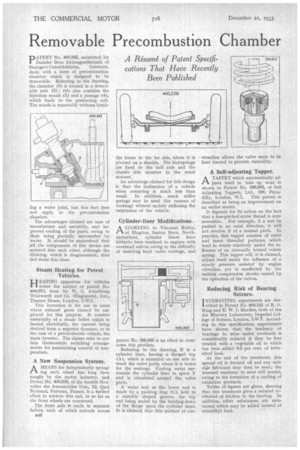Removable Precombustion Chamber
Page 46

If you've noticed an error in this article please click here to report it so we can fix it.
A Résumé of Patent Specifications That Have Recently Been Published
ATENT No. 400,845, submitted by J. Daimler Benz Aktiengesellschaft, of
Stuttgart-Untertiirkheim, Germany, deals with a, form of precombustion chamber which is designed to be removable. Referring to the drawing, the chamber (3) is formed in a detachable unit (2) ;. this also contains the injection nozzle (1) and a passage (4), which leads to the preheating coil. The nozzle is removable without break
ing a water joint, but this fact does not apply to the precombustion chamber.
The advantages claimed are ease of manufacture and assmibly, and improved cooling of the parts, owing to their being partially surrounded by water. It should be understood that all the components of this device are, screwed into each other, although the drawing, which is diagrammatic, does not make this clear.
• Steam Heating for Petrol • Vehicles.
HEATING apparatus for vehicles • forms the subject of patent No. 400,673, from Sir W. G. Armstrong Whitworth and Co. (Engineers), Ltd., Thames House, London, S.W.1.
This invention is for use in cases where exhaust gases cannot be employed for this purpose. It consists .essentially of a steam boiler which is heated electrically, the current being _derived from a separate dynamo, or in the case of a petrol-electric-vehicle, the main dynamo_ The claims refer to certain thermostatic switching arrangements for maintaining control of temperature.
A New Suspension System. PA. A MEANS for independently spring
ing each wheel has long been sought by the motor industry, and Patent No. 400,536, of the Socike Nouvelles des Automobiles Unic, 12, Quai National, Puteaux, France, is a furthef effort to achieVe this end, in so far as the front wheels are concerned.
The front axle is made in separate halves, each Of which extends across 1340
the frame to the far side, where it is pivoted on a shackle. The leaf-springs are fixed to the half axle and the chassis side member in the usual manner.
An advantage claimed for this design is that the inclination of a vehicle when cornering is much less than usual. In addition, much stiffer sprigs may be used (for reasons of braking) without unduly stiffening the suspension of the vehicle.
Cylinder-liner Modifications.
ACCORDING to Viscount Ridley, of Blagdon, Seaton Burn, Northumberland, cylinder liners have hitherto been confined to engines with overhead valves, owing to the difficulty of inserting hard valve seatings, and
patent No. 399,865 is an effort to overcome this problem.
Referring to the drawing, B is a cylinder liner, having a flanged top (A), which is extended on one side to reach the valve ports, where it is bored for the seatings. Cooling water surrounds the cylinder liner in space F and is circulated around the valve ports.
A: water seal at the lower end is made by a packing ring (G), held in a suitably shaped groove, the top end being sealed by the bedding-down of the flange upon the cylinder head. It is claimed that this method of con
struction allows the valve seats to be heat treated to provide durability.
A Self-adjusting Tappet. A TAPPET which automatically adjusts itself to take up wear is shown in Patent No. 399,805, of Self Adjusting Tappets, Ltd., 198, Picca
dilly, London, W.1. This patent is described as being an improvement on an earlier model.
It depends for its action on the fact that a tine-pitched screw thread is nonreversible. For example, if a nut be pushed in an axial direction, it will not revolve if of a normal pitch. In practice, this tappet consists of outer and inner threaded portions, which tend to rotate relatively under the influence of an internally housed volute spring. This tappet will, it is claimed, adjust itself under the influence of a steady pressure assisted by engine vibration, yet is unaffected by the sudden compression shocks caused by the operation of the valves.
Reducing Risk of Bearing Seizure.
I NTERESTING experiments are des
cribed in Patent No. 400,182 of R. 0. Hing and E. W. J. Mardles, both of the Air Ministry Laboratory, Imperial College of Science, London, S.W.7. According to this specification, experiments have shown that the tendency of bearings to seize under overloads is considerably reduced if they be first treated with a vegetable oil to which has been added 0.5 per cent. of tetraethyl lead. At the end of the treatment, this special oil is drained off and any suitable lubricant may then be used; the lessened tendency to seize will persist, owing to the formation Of a coating of oxidation products.
Tables of figures are given, showing that this treatment gives a reduced coefficient of friction to the bearing. In addition, other substances are mentioned which may be added instead of tetraethyl lead.












































































